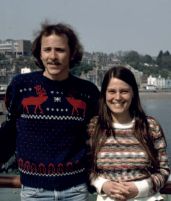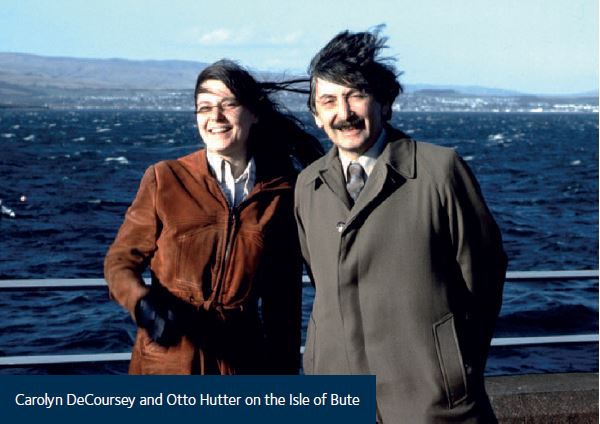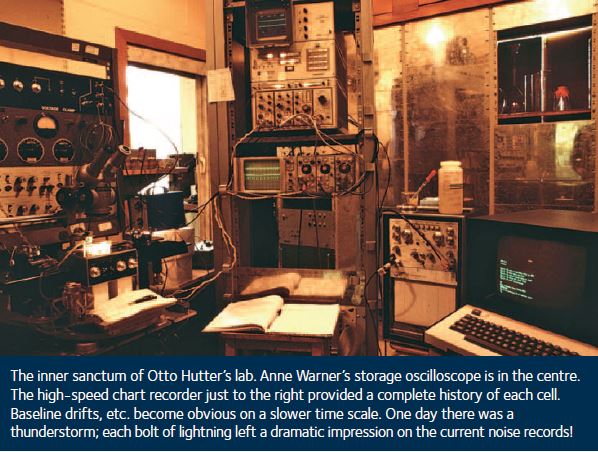
Physiology News Magazine
Memories of a postdoctoral fellowship with Otto Hutter
Membership
Memories of a postdoctoral fellowship with Otto Hutter
Membership
Thomas DeCoursey
Molecular Biophysics and Physiology, Rush Medical College, Chicago, USA
https://doi.org/10.36866/pn.103.42

My first interactions with Professor Otto F. Hutter were by conventional airmail. As I neared completion of my Ph.D. with Professor Shirley H. Bryant at the University of Cincinnati College of Medicine, Cincinnati, Ohio, USA, I sent unsolicited letters to a half dozen labs that I considered to be scientifically exciting. The respondents suggested that I could join their lab provided I could generate my own funding.
Of these options, my wife Carolyn and I chose Glasgow because we could speak English more fluently than German and it was not so far away as Australia, yet was in an exotic location (i.e., not the U.S.). The subject of my dissertation project was a hereditary disease, myotonia congenita, which Adrian & Bryant (1974) [R. H. Adrian of Cambridge] had shown elegantly to be caused by a lack of Cl– conductance in skeletal muscles.
I was of course familiar with the pioneering studies by Otto Hutter and Anne Warner on the pH dependence of the Cl– conductance in skeletal muscle. I applied to the Muscular Dystrophy Association for a Postdoctoral Fellowship to study Cl– channels in skeletal muscle with Professor Hutter in Glasgow. We proposed to determine single Cl– channel conductance in mammalian muscle using current fluctuation (noise) analysis. The start date for the Fellowship was to be January 1, 1980. I received the letter awarding the Fellowship in early December, 1979. This gave my wife Carolyn and me three weeks to sell our house (a tiny structure purchased for ~$10,000 in a dubious neighborhood near the medical center), pack or store all our earthly possessions, and move to Scotland. Those were exciting times! But we were young and crazy!
We arrived in the U.K. via Leiden in the Netherlands, where my older sister has lived most of her life. We took a boat from Den Haag, watched Blazing Saddles before retiring to our below-the-water-line berth, and proceeded to vomit the night away. To this day, my wife refuses to see any Mel Brooks film. We later learned that my sister had inadvertently poisoned us via a tasty sauce kept too long. We took the train north to Glasgow. My instructions were to identify Otto, whom I had never met, at the train station by his carrying a copy of The Journal of Physiology, of which he was an Editor.


Perhaps because I had seen only bound volumes and he was carrying a paperback single issue, I managed to walk right past him. Still feeling peaked and disheveled, we related our miserable tale of travels, to which Otto commented that we evidently were not good sailors! After this inauspicious beginning, things improved spectacularly.
On several occasions, Otto and his wife Yvonne took us to their vacation home in the village of Kilchattan Bay on the Isle of Bute. This was a fine house in a small community facing the bay, where we could fish for cod or dig mussels. Hiking was excellent, with bright yellow gorse blooming and nearby a nice example of columnar basalt (the hexagon-shaped columns that are also seen in the Devil’s Tower in Wyoming). Otto explained that one of the virtues of Scotland was that landowners could not prohibit hiking across their land – provided that you respect the property and leave it as you found it.
Otto once related a story of when he moved to the UK from Austria in 1938, escaping the German occupation. During his first day at school (at age 14), the teacher introduced him to the class as a new student. She pronounced his surname Hutter (as we say it now, rhyming with ‘butter’). He immediately corrected her pronunciation, ‘It is pronounced Hutter’ (‘hooter’ – the German pronunciation, rhyming with scooter; or worse, did it have an umlaut?). Later, on the playground, the other children made fun of his name ‘Hooter’ (i.e. big nose). From this experience, Otto concluded that when one lives in a country where the inhabitants are not able to pronounce your name correctly, you should simply allow them to pronounce it the way they are able.
The first lesson Otto impressed upon me was that when one receives a letter that demands a response, it is essential to reply immediately. Even if all you can say is that you have not yet made a decision, it is important to keep the correspondent aware of the situation. The occasion for this admonition was that I had written to Professor Hutter to enquire about a position, he had responded favorably, and I had communicated nothing for about 6 months. Then suddenly I appeared on his doorstep! Although I still err on this point occasionally, I do so far less often.
Another important lesson was how to give a scientific talk. Otto suggested that I present my Ph.D. dissertation results at The Physiological Society meeting in June 1980 in Oxford. If I had known that the likes of Andrew Huxley and Bernard Frankenhaeuser would be in the audience, I would have never had the courage to proceed. Otto had me practice beforehand, and I learned a great deal. When you use a pointer, especially a laser pointer (which did not exist at that time), do NOT wave it around wildly. Point directly at the part of the image you are discussing, and hold the pointer still. To this day, when I see a lecturer waving the pointer randomly or continuously in circles, I can envision Otto shaking his head in dismay. When you show a graph, tell the audience what is plotted. Do not expect them to read the axis labels themselves – it is your job to explain to them what they are seeing, and more importantly, what you want them to see. You say, ‘Here we plot…’ and at the same time point at the graph. It seems obvious, but it is amazing how often this is not done.
In those days, papers were written by hand (with a pen or pencil on actual paper), then typed by a secretary (if one were so fortunate), and then edited by means of cutting and pasting (or more literally, taping). Manuscripts gradually turned in to scrolls. Here are some of the rules that Otto taught me during this period, about writing and about reviewing manuscripts and grants:
- A manuscript reviewer may make all kinds of criticisms on the first round of reviewing, but on the second round, it is not acceptable to introduce a new complaint. One may address only the resolution of those complaints that were duly noted in the first round. I wish the referees for Nature and their offshoot journals would learn this rule!
- Otto stressed the importance of writing a thorough and accurate Methods section, which I found quite tedious to write. Its purpose is not so much for readers of the paper, but rather to remind the authors precisely what they did a few years later.
- Otto felt that one should write down everything one would like to say, and then take away all superfluous words. The resulting sentence will be concise, yet easier to understand, and less ambiguous. The adverb ‘very’ is empty and should never be used – there is always a more descriptive word that can replace it.
- A very (oops!) important point is that a manuscript should include one or several sentences that tell the reader clearly what s/he is supposed to learn from the study. However obvious the conclusions appear to the writer, the reader is less intimately acquainted with the work, and needs to be told what to think. This is perhaps even more important when writing a grant application. The reviewers do not want to have to think for themselves (and might not arrive at the correct conclusions) – your job is to provide them with all the summary phrases and conclusions they will need to understand the paper or write their review.
- When a lucid thought came into being during a discussion, if it did not fit into the section of the manuscript we were working on, we wrote it down on a scrap of paper, and put it into a small box. When the writing was nearly finished, we would look through the box and retrieve any lost gems.
- Precise wording was of the utmost importance. One day we worked from 9-11am, when everyone was required to go to the Tea Room and have tea and biscuits. By tea time, we had managed to complete one solitary sentence. Just before we left for tea, we crossed it out.
- While doing experiments, it is helpful to make a note of any cell that has particularly beautiful currents. One is always searching for the ‘typical’ experiment to use in figures. A cell that behaves normally, produces complete measurements without odd features, and which is aesthetically pleasing may occur just once, if ever, and is to be cherished!
- Otto felt that the best work is done by at least two scientists – one to work the controls or the computer and change solutions, the other to take thorough notes in the lab notebook and help think what the next measurement should be. This approach remains valid for electrophysiology, in which each cell has a finite and often brief lifespan, and it is important to get all the information from each cell that is humanly possible.
- Otto advised that it is better to make positive contributions than to attack prevailing ideas. The latter must be done sometimes, but this should not be the basis for one’s reputation.
Otto showed me the lab, the set-up I would use, and introduced me to John Dempster, who worked on the project too. He was a very clever native Scotsman, whose lowland accent I eventually learned to understand, almost. Our attempts to extract Lorenztian power spectra from Cl– current fluctuations failed. We induced fluctuations by changing the pH, which Hutter & Warner (1967; 1972) had shown introduced time-dependence into the nearly time-independent Cl– conductance at neutral pH. Unfortunately, these fluctuations were too slow, with time constants of hundreds of milliseconds. After this situation became clear, Otto suggested that we change course and study inwardly rectifying K+ channels, which have the virtue of much faster kinetics (in the range 1-5 ms). These channels proved to be amenable to our approach, and we eventually published two papers in The Journal of Physiology (DeCoursey & Hutter, 1984; DeCoursey et al., 1984), my first high-quality publications.
Then approaching age 60 and Department Chair, Otto still visited the lab and occasionally did actual experiments. One day he dissected a turtle to obtain the heart, which entailed his wearing wonderful aviator-style goggles and using a hand-held power saw to cut through the shell.
The final two months of my precisely 2-year fellowship (the US-UK tax treaty allowed us to pay US tax only, provided we did not stay one day longer than two years – an extra day would mean paying two years of tax retroactively to the UK) were among the most memorable. I spent most of each day sitting next to Otto in his gorgeous sunny office overlooking Kelvingrove Park, writing papers. This was when I learned most of what I know about writing scientific papers. I had to sit on Otto’s right side, because he was practically deaf on his left side. Even so, and despite his hearing aid, I still had to shout at a considerable volume to be heard. The two secretaries sitting in the next room were aghast at the impudent American shouting at the distinguished Chairman of the Physiology Department. In general, I got away with a lot in Scotland, being excused as being just an American who did not know any better. In fact, there was some truth to this, because I was an American, and I really did not know any better!
Toward the end of my postdoctoral stint, we felt we had enough good ‘normal’ data, but that it would help validate the results if we could obtain data at a different temperature, to confirm that the results varied as might be expected. The experimental chamber lacked temperature control, but it was winter so I opened all the windows in the lab and did measurements at ~10°C. True to the Rule of Science, these final experiments, done with limited time available in order to ‘clinch’ the story, produced no useable data.
When I left Glasgow near the final day of December 1981, I thought that we had finished our manuscript and were ready to submit. Otto’s perspective was, however, quite different. He decided that we should correct certain systematic errors that crept into the results due to the geometry of skeletal muscle. The voltage clamp can control the surface membrane potential, but the membrane extends into tiny topologically continuous ‘t-tubules’ and as they descend into the interior of the fibre, their membrane voltage deviates progressively from the ‘command potential’. John Dempster attacked this mathematical problem and produced quantitative corrections. Meanwhile, I had moved on to a postdoctoral position in Michael D. Cahalan’s lab at the University of California at Irvine. Serendipitously, Otto’s daughter lived in Pasadena (50 miles north across all of Los Angeles) so he came to visit on two occasions. Besides seeing his daughter, he spent some time with me working on the manuscripts. By now, the paper had been divided into two. Eventually, the papers were submitted and appeared in 1984 (DeCoursey & Hutter, 1984; DeCoursey et al., 1984), more than two years after the last experiment had been done.
The value of a foreign postdoc
I credit Otto with dramatically advancing my career in many ways. He once told me that to succeed as a scientist one must be willing to do whatever was necessary. The example he gave was traveling to a foreign country to take advantage of unique opportunities. Having a foreign postdoctoral experience elevates you to a different level. Americans are secretly in awe of British science, with a tradition of excellence that produced Hodgkin and Huxley, to name obvious examples. Europeans (including Brits) recognize that the United States remains at the forefront of modern science, in part by sheer volume, but they also value the disappearing American tradition of pushing relentlessly forward and getting things done, surmounting or ignoring all obstacles. Otto is correct on both counts – the experience has intrinsic value, but more importantly, it reflects your dedication to do what is necessary to advance your career. On a practical note, the postdoctoral era is one time when you can explore life anywhere in the world, with no commitment or expectation to stay. I would not trade those two fabulous years in Glasgow for anything.
